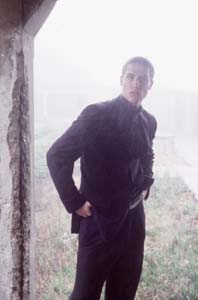![[MetroActive Arts]](/arts/gifs/art468.gif)
[ Arts Index | San Francisco | MetroActive Central | Archives ]
San Francisco image consultants preach the gospel of looking good
By David Mills
Marilyn Burns claims she was born without the "shopping gene." "Give me any kid and in a half hour I can tell you how much the kid knows about math. Shopping? Forget it," says the 57-year-old educator from Sausalito. For a while, she preferred to make her own clothes--peasant skirts, plain shirts, practical, unremarkable slacks--than to deal with the unknowable mysteries of shopping.
In working with kids all day, Burns' functional wardrobe with hippie chick overtones was never a problem. Comfort was the only major hallmark of Burns' personal style. However, 15 years ago, when Burns began giving seminars around the country, teaching teachers about new approaches to math, fashion suddenly became much more important. She remembers one occasion vividly.
"I was in New York giving a talk to about 300 people. They were all dolled up. This was New York, after all. I thought, 'What am I doing?' I looked like a slob and they felt uncomfortable."
Burns had to do something. Her career was taking a new direction. Soon she would leave the classroom altogether and concentrate full time on public speaking, improving the skills of other teachers. She could clearly see what was coming for her, where her career would lead her. She just had no idea what to wear. So she turned to someone who did--an image consultant.
Image consultants have been around forever. When early man first threw on the skin of a bison to keep him warm, an early image consultant taught him how it should hang to attract the opposite sex. Kings, queens, presidents and Hollywood stars have always had a coterie of advisers to provide input around what external image to project and how to do it. These advisers instinctively knew that how an individual is perceived by others is critical.
"What does that really mean when people say, 'What am I going to wear?' It means 'How will I be seen?' 'How will I be perceived?'" says Gwen Mazer of Total Image Management Design and Development.
It's only in the past 20 years that image consultants have started offering their services to working professionals. It was in the early '80s as women were streaming back into the workforce in record numbers that personal image consulting began to catch on. With the 1975 release of John T. Malloy's Dress for Success, people everywhere began to realize that fashion and style could have a critical impact on one's career.
Today, dressing for success means more than just wearing a business suit. It means being comfortable, professional and still individual. But as Marilyn Burns asked herself 15 years ago, "How am I supposed to know where to start?"
Professional image consultants offer a range of personal services, including advice and training on hair and makeup, building a basic wardrobe for any occasion, appropriate table etiquette in business and social settings, even how to use chopsticks correctly.
"A lot of people who come to me are going through some life change," says John Kitchener, a San Francisco-based image consultant with more than 20 years of experience. "Divorce, moving, changing careers: it's almost like they're coming to me for some kind of counseling."
Kitchener is known mostly as a color consultant. He's developed a sophisticated technique to help individuals identify what colors and combinations of colors successfully express who they are personally and professionally. "To stay in visual harmony, you express the qualities that you have, not the qualities that you don't have." According to Kitchener, people can be classified as combinations of the following "style identities": angelic, youthful, romantic, classic, natural, high-spirited and dramatic. "I'm 30 percent dramatic, 30 percent classic, 30 percent romantic, and 10 percent high-spirited," Kitchener confides. "In a sense, I'm doing readings for people."
To do such a reading, Kitchener considers bone structure, complexion, hair type, coloring and body type to identify the dominant qualities of each client--qualities many clients don't even know they have.
"I had one client who was in touch with his classic side but not his romantic side. He never expressed romance in his image. Well, I went shopping with him. Now he wears these wonderful blousey pants that are full pleated. He wears his jackets more open. He looks much more like himself. He says he feels like a 10 all the time!"
Most image consultants will tell you that image isn't everything. However, it is more important than most of us think, especially in the professional and social sphere. In addition, many of us never learned the skills we needed to manifest ourselves externally. Still wearing the clothes your mother dressed you in? You're probably manifesting your mother's image of yourself. (No wonder you can't get a date!)
After 15 years as an image consultant, Gwen Mazer gets clients through referrals. "A client comes to me and we sit down and have a conversation. What's going on for you? Why are you here?
"If I go to someone's home, we do a wardrobe review and evaluation. They ask, 'Can we save this? I've always loved it.' I might look at it and say, 'Perhaps it's something for the memory closet.'
"Once we've gone through that process, we talk about where we're going, what we're going to develop. What is it going to look like? In that process we might discuss fitness training, seeing a nutritionist, seeing a hair stylist, seeing a makeup artist, seeing someone for skin care, starting a massage program, finding the voice coach, leadership training. I offer a holistic package. Because it's not just the clothes that go on your body--it's everything that has to do with your personal presentation."
Marilyn burns, the math teacher, went to see Gwen Mazer 15 years ago and has returned two or three times a year ever since. "Look, I'm not interested in being glamorous," Burns says. "My whole goal with this has been to improve how I present myself to the world. I told Gwen, I need clothes that are flexible, that can pack easily and that look good. We've done two major cleanings of my closet: when I first came to Gwen and when I let my hair go gray. My family has been telling me for the past 10 years that I look fabulous. I'm more attractive now than ever before!"
While working within the boundaries set by the client--based on budget, lifestyle, needs, etc.--a good image consultant will nonetheless push the client to experiment with their look.
"The trickster in me wants to take people right to their limit," says Kitchener. "One client wanted to be more romantic. Fine, I said, we're going to get you into your reds. I got this Liz Claiborne shirt. He put it on and said, 'Oh my God, I can't go outside.' I said, 'You damn well will! You want to be more romantic, more sensual, more male, more out there. This red will put you more out there. You put on this red shirt and your tightest jeans and you go to Alta Plaza or wherever you have to go and you'll blow them away!' And he has!"
After Gwen Mazer coaxed plain Jane Marilyn Burns into wearing scarves and accessories, she suggested Burns start wearing makeup too. "At first I laughed! Now, I wear makeup. Just a little," Burns says.
Mazer introduced Burns to Jim Avila, a local image consultant who focuses on hair and makeup. Avila's list of celebrity clients runs from film star Isabella Rossellini to local news anchor Elaine Corral. Avila has even done makeup for men, including Raymond Burr and Luke Perry.
"I've worn makeup for I don't know how many years," admits Avila happily. "It makes me look 10 years younger."
In addition to his work in video, theater, print and film, Avila does hair and makeup for 60 to 70 weddings a year. Twenty years of experience making up celebrities and brides has given Jim Avila a unique insight into the art of the face. The secret to beauty is simple, Avila contends: eyebrows.
"Seventy percent of what I do is eyebrows. They represent the most important line on the face. Eyebrows must arch! You can look alive and happy or down and depressed. It's that simple."
If it were that simple, Arianna Huffington never would have called Avila and begged for his services. "I wasn't interested. There is a tightness, a rigidity that comes through when someone is pushing that God agenda. That rigid, tight hairdo. It's the whole look. I said, Forget it."
Syndi Seid, president of Advanced Etiquette, believes there's more to presentation than arched eyebrows. "I feel etiquette and appropriate behavior should be the number-one thing a person should concentrate on. It's more important than being colored beautiful or dressing for success."
Seid trains people in the art of manners and etiquette--business professionals, job applicants, even new home buyers "movin' on up to more ritzy neighborhoods."
"A very timid young woman called me. She came from Vietnam; she had been a boat person who now had been here 10 years and built up a very successful business with her husband. They were about to buy their first house and she really wanted to feel confident going out to parties and social situations. I asked her where she and her husband were looking to buy their house. She said, Hillsborough!"
It turns out, all those things your mother tried to teach you matter. Seid contends that table manners, introductions, even how you pass a business card are extremely important behaviors that can create a more lasting impression than your wardrobe, hair and makeup, especially in the international business world.
"I really want to help people gain self-confidence and authority in areas that not everyone has the opportunity to learn at home. How to use the right knife and fork, shaking hands, introductions--none of these things were taught in my home. These things are important if a person wants to climb the social or corporate ladder and just to feel better about yourself."
While Seid uses a common-sense approach and relies on her casual charm to get her message across, don't get the impression that she's a pushover when it comes to etiquette. "I would say there are hard and fast rules. When you're meeting someone on the phone and you haven't ever met them before, you should address them as Mr. or Ms.
"If you're going to conduct business in the international arena, you need to learn the proper way of crossing your legs, men especially. A continental leg cross has one leg over the other all the way and your toes pointing towards the floor. A figure-four, where you rest your ankle on your knee, in many Middle Eastern and European countries is considered a very vulgar position."
Ruth Pimlott consulted with Seid about international dining etiquette before launching a world tour. "We all want guidelines," Pimlott admits.
Seid advises eating in the European manner when abroad. That's when the fork is held tongs down in the left hand and the knife is held in the right hand. The typical American cut-and-switch method should stay at home. "Syndi had the answers to all sorts of difficult questions," Pimlott says. "For instance, bread." (Seid advises tearing off a small piece and focusing on eating it before moving on to additional pieces.) "And lettuce in a salad can be very difficult, too. You can't cut lettuce with a knife. Syndi suggested folding the lettuce to make it more manageable."
While Pimlott raves about her etiquette training with Seid, she's since come up with dozens more etiquette dilemmas, like what happened to an acquaintance who, while eating a Cobb salad, somehow shot a cherry tomato across the room. "What could she do? Everyone saw it. Everyone was waiting for her to do something. She couldn't just leave it there--someone might step on it and slip! Well, she just remained calm, walked over and picked it up and put it on a saucer that she would not be eating from. Everyone was so relieved."
Seid's approach to etiquette is to behave in a way that makes everyone feel comfortable and avoids embarrassment. Pimlott's friend relieved the tension in the room by smoothly diffusing a potential danger. "It's less about right and wrong," Pimlott contends. "It's about what will make everyone feel comfortable."
According to Seid it's never too early to learn proper etiquette. In her upcoming seminar series at the Clift Hotel, she even has classes for adolescents. The seminar includes instruction in how to give and attend a party, sending invitations and writing thank-you notes, how to set a dinner table, how to eat fruit and shrimp cocktail, toasting, talking to servers, and difficult situations involving drugs and alcohol.
Marilyn Burns--the math teacher who blossomed under the tutelage of an image consultant--has referred countless friends to her image consultant. "It only works if you're ready for it. You have to be open." You also have to have the money. Image consulting services aren't cheap, but the payoff can be worth it.
"When I go to the symphony and I see some of the people there!" Burns exclaims. "Even the singers. They stride out on stage in these unflattering outfits. I think, 'You need an image consultant!'"
[ San Francisco | MetroActive Central | Archives ]
Copyright © Metro Publishing Inc. Maintained by Boulevards New Media.
![]()
 Style Counsel
Style Counsel
Photographer: Dayve Morffy
Model: Robert from City Models
Stylist: Yael Gital of WorkGroup
Grooming: Raquel Breen
Black suit: Prada
 And that's the goal, Kitchener exclaims--to get people to feel better about themselves by expressing who they are more successfully. "People can use this in terms of their own psychological counseling. This one therapist and I have worked together on several clients. He will work with a client in a therapy situation and then send them over here to get their style information done. This one gal has been totally turned around in her life because of it. When she found out she was romantic and high-spirited, she began working with her therapist on these qualities and trying to get really in touch with them. She's now creating career work based on her sensual and more playful sides." And what kind of work is based in sensuality and playfulness? "Something about wine tours."
And that's the goal, Kitchener exclaims--to get people to feel better about themselves by expressing who they are more successfully. "People can use this in terms of their own psychological counseling. This one therapist and I have worked together on several clients. He will work with a client in a therapy situation and then send them over here to get their style information done. This one gal has been totally turned around in her life because of it. When she found out she was romantic and high-spirited, she began working with her therapist on these qualities and trying to get really in touch with them. She's now creating career work based on her sensual and more playful sides." And what kind of work is based in sensuality and playfulness? "Something about wine tours."
 Avila works to achieve a classic look. He describes it as "early Liz Taylor, very Vivien Leigh." While he has been doing hair and makeup for over 20 years and has experience as a designer and stylist for clothier Jessica McClintock, Avila got his real education from the movies. "Bette Davis, Sophia Loren, Marilyn Monroe"--Avila has based his personal makeup technique on the classic style inspired by these and other Hollywood stars. Is it any wonder that one of his favorite clients is transsexual blues sensation Veronica Klaus?
Avila works to achieve a classic look. He describes it as "early Liz Taylor, very Vivien Leigh." While he has been doing hair and makeup for over 20 years and has experience as a designer and stylist for clothier Jessica McClintock, Avila got his real education from the movies. "Bette Davis, Sophia Loren, Marilyn Monroe"--Avila has based his personal makeup technique on the classic style inspired by these and other Hollywood stars. Is it any wonder that one of his favorite clients is transsexual blues sensation Veronica Klaus?
 So are image consultants the only way to feel good about yourself and look good? Probably not. We all know people who have been extremely successful socially and professionally without ever going to a consultant. However, just think how successful they might be if they had gone.
So are image consultants the only way to feel good about yourself and look good? Probably not. We all know people who have been extremely successful socially and professionally without ever going to a consultant. However, just think how successful they might be if they had gone.
From the September 27, 1999 issue of the Metropolitan.